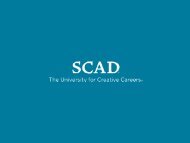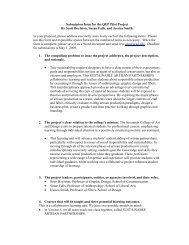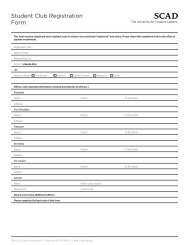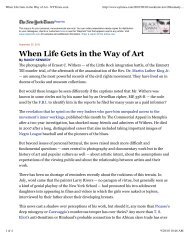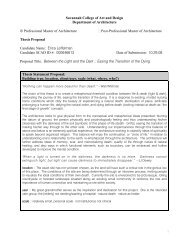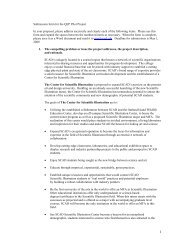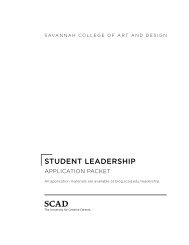Nicole Roberts MFA Thesis Visual Component Artwork - Savannah ...
Nicole Roberts MFA Thesis Visual Component Artwork - Savannah ...
Nicole Roberts MFA Thesis Visual Component Artwork - Savannah ...
Create successful ePaper yourself
Turn your PDF publications into a flip-book with our unique Google optimized e-Paper software.
EXPECTATION 7 | social responsibility<br />
Amongst industry professionals, the notion<br />
of social responsibility also spawns discussions<br />
concerning the need for students to increase their<br />
cultural awareness prior to entering the twentyfirst<br />
century workplace. “Today’s new pluralism<br />
in graphic design must be seen as a response to the<br />
greater multiculturalism of today’s global society.” 33<br />
With the opulence of technology and our expanded<br />
global demands, the audience for which we design is<br />
increasingly important. Design history lectures will<br />
always idolize the “universal” design solutions of<br />
Bauhaus Modernism as the true “international style”<br />
of yesteryear. But with the new wave of social media<br />
and other forms of technology that broaden our<br />
communicative abilities, there is no longer such a thing<br />
as a universal audience. 34 With each project, students<br />
must learn to become experts on “the audience’s<br />
values, symbolic codes, and communicative styles;<br />
and preferred media and distribution channels must<br />
inform how we shape the written message.” 35 The First<br />
Things First manifesto reminds us that designers have<br />
the potential to create messages that have a profound<br />
impact on the world. Opportunity for pedagogical<br />
change rests in infusing practical principles of design<br />
ethics in students by requiring each studio project to<br />
fully research the global audience’s perspective and<br />
incorporate aspects of social responsibility by concept,<br />
process, and production.<br />
Design is directed toward human beings.<br />
To design is to solve human problems by<br />
identifying them & executing the best solution.<br />
Ivan Chermayeff<br />
33 Fiell, 8<br />
34 Katherine McCoy, “Maximize the<br />
Message: Tailoring Design for Your<br />
Audience in a Multicultural Era,” in The<br />
Education of a Graphic Designer, ed.<br />
Steven Heller, (New York, NY: Allworth<br />
Press, 2005), 279.<br />
35 Ibid, 283.<br />
The First Things First manifesto<br />
was published in January 1964.<br />
Inexplicably, reverberations are<br />
still apparent.<br />
44




